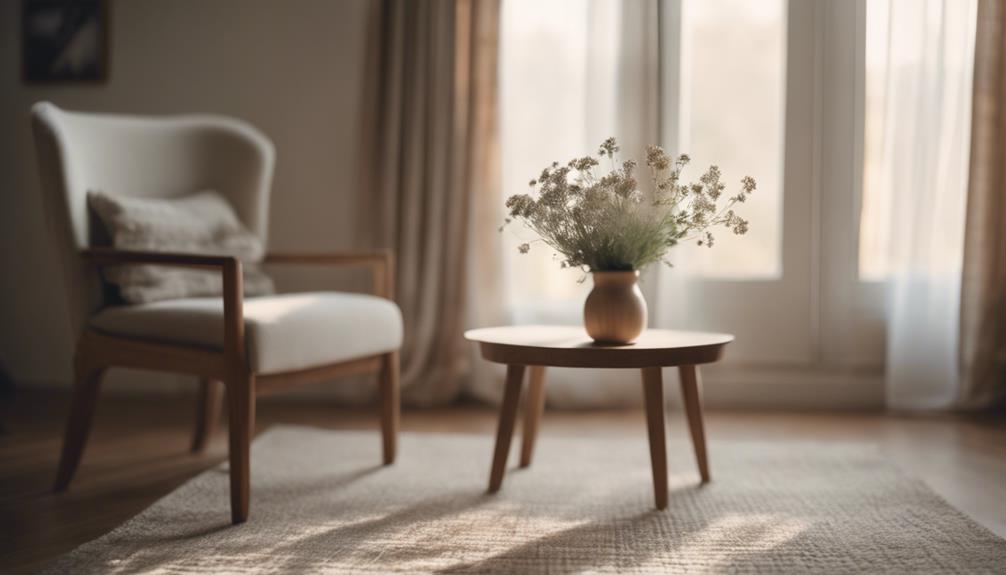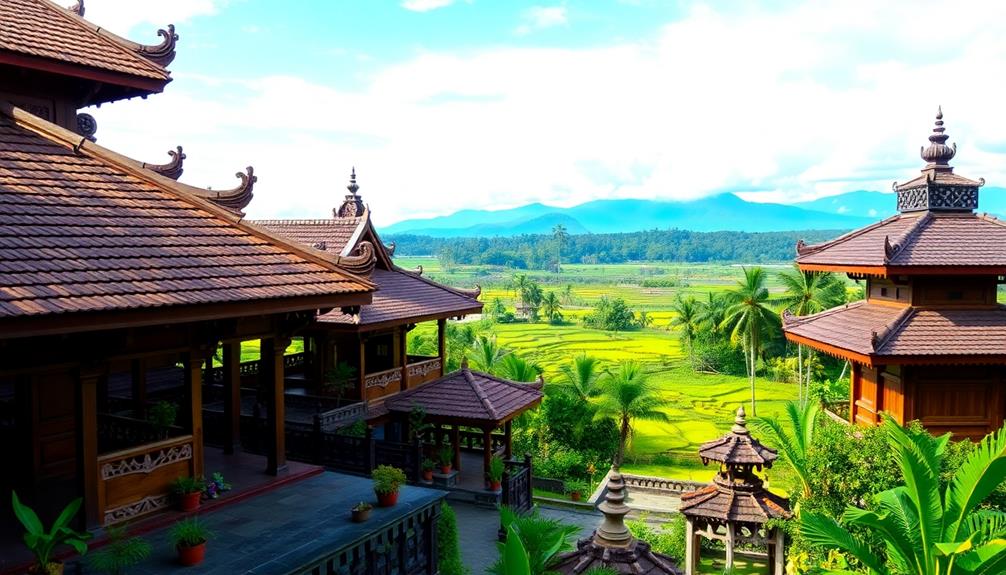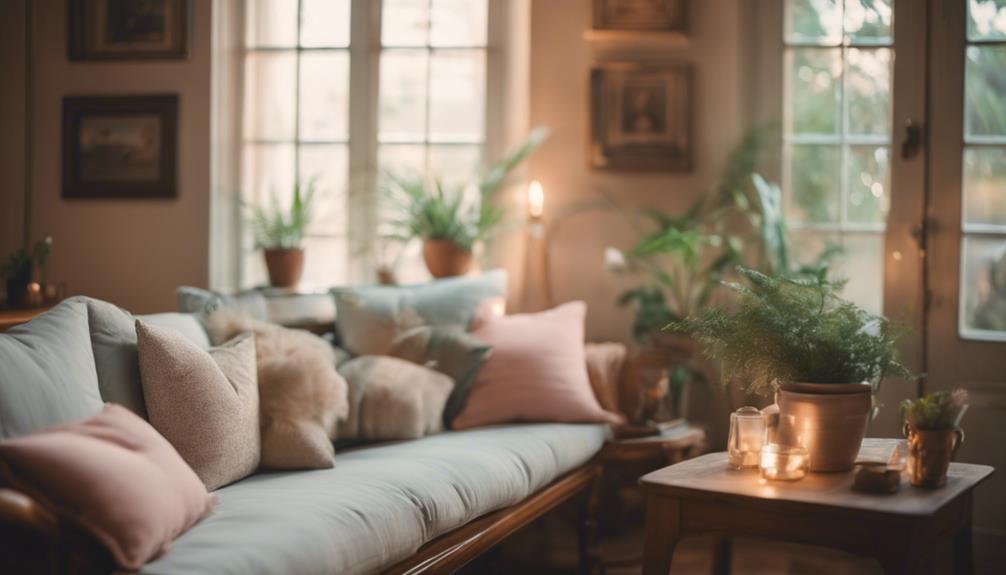Combining Cottagecore's warmth with Minimalism's simplicity transforms your home into a serene sanctuary. Start by using a tranquil color palette of earthy tones and soft pastels to maintain a calm atmosphere. Incorporate natural materials like wood and stone for warmth while selecting fewer, curated decor items that reflect your personal style. Layer textures with textiles and vintage finds to add depth without clutter. Don't forget cozy lighting with warm tones for ambiance. This blend creates a peaceful space where comfort meets simplicity, encouraging a restful environment. There's so much more to explore for your perfect peaceful retreat.
Key Elements
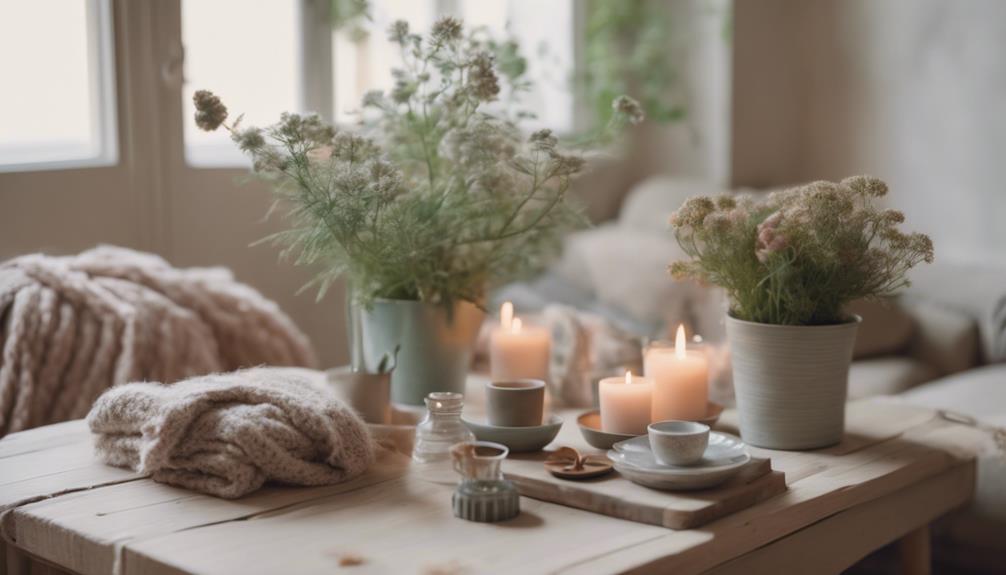
When creating a peaceful home, the right color scheme, materials, and textures play an essential role.
You'll want to choose soft, earthy tones that complement natural materials, establishing a calming atmosphere.
Color Scheme
A Minimalist Cottagecore color scheme embraces a tranquil neutral palette, featuring soft whites, beiges, and grays that create a serene backdrop for your home. This color palette promotes tranquility, allowing you to feel relaxed and at ease.
To enhance this calming effect, consider incorporating soft pastel accents like sage green or powder blue. These muted colors add a touch of warmth and charm without overwhelming the space.
Earthy tones, such as rustic brown, terracotta, and olive green, deepen your connection to nature, fostering an inviting atmosphere. Using these colors, you can cultivate a cozy environment that aligns perfectly with minimalist principles.
The cohesive use of muted colors and natural materials helps maintain an uncluttered aesthetic, ensuring your home feels peaceful and harmonious.
Don't forget to integrate vintage charm into your design. Antique touches, characterized by worn paint or aged patina, can enrich your color scheme, adding depth and authenticity while keeping the overall look minimalist.
Materials
Natural materials like wood, stone, and organic textiles are essential for creating a warm and inviting atmosphere that embodies both Cottagecore and Minimalism. By incorporating these elements, you'll establish a grounded and tranquil environment. Choose cozy furniture crafted from natural woods or soft fabrics that invite relaxation while maintaining functionality.
Adding vintage finds or antique pieces can bring character and history into your home, enhancing the decor without overwhelming the space. These selections can serve as conversation starters while fitting seamlessly into your minimalist aesthetic.
Stick to a neutral color palette featuring soft whites, beiges, and muted grays, paired with subtle pastels like sage green or powder blue. This approach fosters a serene and harmonious backdrop, allowing the beauty of your natural materials and vintage treasures to shine through.
Limit your decor items to a curated selection that truly reflects your personal style. By celebrating simplicity and beauty, you'll guarantee only the essentials are displayed, maintaining an uncluttered space that feels both peaceful and inviting.
Embrace these materials for a balanced home that perfectly marries Cottagecore charm with minimalist sensibilities.
Textures
Incorporating a variety of textures like wood, stone, and organic fabrics creates a serene atmosphere that beautifully aligns with both Cottagecore and Minimalism principles. You'll want to focus on natural beauty by choosing materials that evoke a sense of calm.
Textiles such as linen, cotton, and wool add warmth and comfort while maintaining the understated elegance that characterizes this style.
Consider integrating vintage furniture pieces that feature weathered wood or unique ceramics. These elements enhance your decor, providing depth and character without cluttering the space. Layering textures is key; cozy throws, handwoven baskets, and soft rugs can create a warm and inviting environment.
To achieve a harmonious blend, opt for a neutral color palette filled with earthy tones. This approach not only promotes a peaceful atmosphere but also allows the textures to shine through.
Essential Fixtures and Furniture
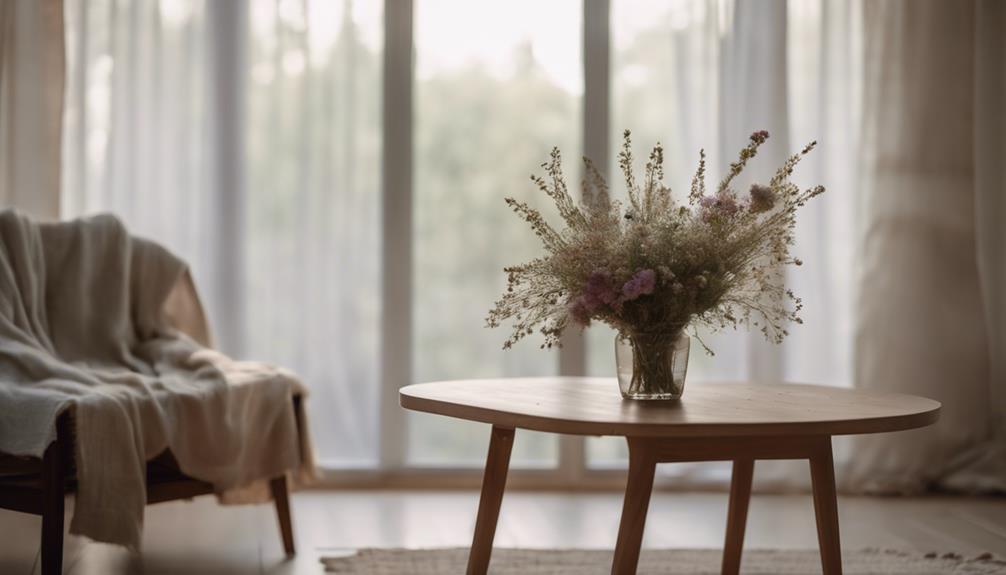
When you think about essential fixtures and furniture for your cottagecore-inspired minimalist home, consider pieces that blend function and style.
A reclaimed wooden dining table serves as a centerpiece for gatherings, while a vintage wicker armchair adds comfort and character.
Don't forget a handcrafted ceramic side table to enhance the cozy atmosphere with a personal touch.
Reclaimed Wooden Dining Table
A reclaimed wooden dining table not only adds warmth and character to your home but also embodies the sustainable principles of the cottagecore and minimalist lifestyle. By choosing this piece, you're opting for a table that showcases unique wood grain variations, creating a focal point that radiates rustic charm. It fosters an inviting atmosphere, perfect for family gatherings and shared meals, aligning perfectly with cottagecore values of connection and community.
Incorporating a reclaimed wooden dining table into your space promotes mindful living. Its versatility allows you to blend vintage and contemporary designs, ensuring it complements your decor while maintaining a minimalist approach. You'll appreciate the quality over quantity philosophy inherent in these tables, which often come from local artisans committed to sustainable practices.
As you gather around this table, you'll find it encourages meaningful conversations and memories, bringing an essence of warmth to your minimalist cottagecore home. Ultimately, a reclaimed wooden dining table serves as a beautiful reminder of nature's beauty, enhancing your living space while supporting responsible consumption and craftsmanship.
Vintage Wicker Armchair
Embrace the charm of a vintage wicker armchair, which effortlessly combines functionality with the cozy aesthetics of a Cottagecore-inspired home. This piece not only serves as a multifunctional fixture but also adds character while aligning with minimalist principles. The use of natural materials in wicker creates an organic aesthetic that enhances the inviting space.
Vintage wicker armchairs often feature intricate patterns and textures, contributing to a cozy charm without overwhelming your room. They fit perfectly in a decluttered environment, allowing the beauty of simplicity to shine through. Imagine curling up with a book in a serene reading nook, where the armchair encourages relaxation and mindfulness—two essential elements of both Cottagecore and minimalist lifestyles.
Choosing a vintage wicker armchair supports sustainability by repurposing items and brings unique history into your decor. Each piece tells its own story, adding depth and personality to your home. By incorporating this charming fixture, you create a warm, inviting space that resonates with both aesthetics, making your home not just a living area but a peaceful retreat.
Handcrafted Ceramic Side Table
Handcrafted ceramic side tables blend functionality with artistic flair, making them essential fixtures for a peaceful home. These unique pieces embody the perfect fusion of minimalist design and the rustic charm characteristic of Cottagecore decor. Their organic textures and earthy tones enhance your connection to nature, promoting a serene atmosphere in any room.
Incorporating a handcrafted ceramic side table into your cozy living space allows for practical use, whether you're holding books, beverages, or even a small potted plant. Each table's individuality adds a personal touch to your decor while keeping your environment uncluttered and intentional.
When you select a side table that reflects Cottagecore's vintage charm, you enhance the warmth of your home, creating an inviting atmosphere that encourages relaxation. This combination of natural design and functionality aligns beautifully with minimalist principles, ensuring that your space feels both stylish and serene.
Lighting Ideas
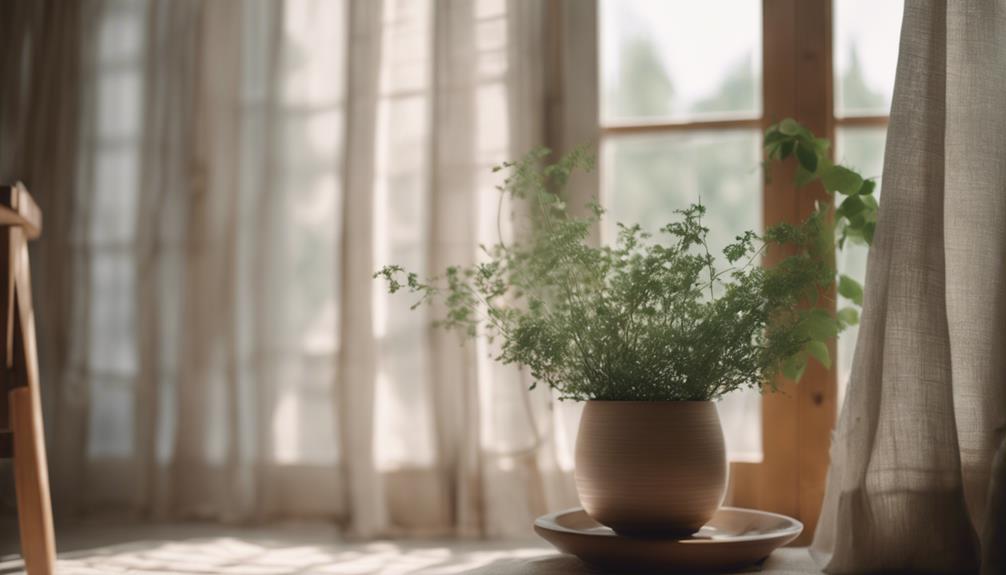
When it comes to lighting, you can enhance your Cottagecore and minimalist vibe with soft, warm pendant lights and vintage lanterns for a cozy touch.
Don't forget to let natural light pour in through large windows, creating a bright and inviting atmosphere.
Adding rustic fairy lights can also bring a whimsical charm to your space, making it feel peaceful and serene.
Soft, Warm Pendant Lights
Soft, warm pendant lights instantly transform your minimalist Cottagecore home into a cozy retreat, casting gentle illumination that highlights natural materials and neutral tones. These lights enhance the serene ambiance, creating a perfect atmosphere for relaxation and unwinding.
By choosing pendant lights with organic shapes or vintage-inspired designs, you can seamlessly integrate them into the Cottagecore aesthetic, adding charm without cluttering your space. Opt for materials like wood, rattan, or glass to maintain that connection to nature while keeping your design simple and functional.
Dimming options or warm-toned bulbs allow you to adjust the lighting to suit different moods, making it easy to create a peaceful environment. Positioning these soft, warm pendant lights above kitchen islands or dining areas serves not just as practical lighting but as focal points that balance functionality with aesthetic appeal.
They encourage a sense of togetherness, inviting family and friends to gather in your welcoming space. So, invest in pendant lights that embody these qualities, and watch how they elevate the overall feel of your home, harmonizing both Cottagecore and minimalist ideals.
Vintage Lanterns for Ambient Lighting
Vintage lanterns bring a warm, inviting glow to your space, enhancing the Cottagecore aesthetic while providing versatile ambient lighting. These charming pieces, often made from metal and glass, create a cozy atmosphere that complements a minimalistic design. The soft light emitted by vintage lanterns can transform any room, adding warmth without overwhelming your decor.
Consider incorporating battery-operated or solar-powered vintage lanterns for both sustainability and convenience. These options allow you to place them anywhere, free from the constraints of electrical outlets. Plus, collecting unique lanterns from flea markets or thrift stores not only adds character to your home but also aligns with a sustainable lifestyle by repurposing old items.
You can use vintage lanterns indoors or outdoors, making them perfect for creating serene spaces. Place them on a dining table for a romantic dinner, or hang them in your garden to enhance your outdoor experience.
Rustic Fairy Lights String
Rustic fairy lights string adds a warm, inviting glow to your minimalist Cottagecore home, effortlessly enhancing its cozy atmosphere. These lights, with their soft, muted tones like warm white or soft yellow, seamlessly blend with your rustic wooden furniture and neutral color palette. This combination creates a serene environment, allowing you to relax and unwind.
Consider incorporating these fairy lights in unexpected places to create whimsical focal points. You might drape them over shelves, wrap them around window frames, or even place them inside glass jars. This approach adds charm without cluttering your space, staying true to the minimalist ethos.
Battery-operated options provide flexibility, letting you position lights where you want without visible cords. This feature aligns perfectly with the simplicity and functionality central to both Cottagecore and minimalism. By choosing lights made from natural materials like rattan or wood, you maintain the earthy textures that define this aesthetic.
Incorporating rustic fairy lights string in your home not only elevates the ambiance but also invites a sense of warmth and coziness, making it a perfect retreat from the outside world.
Natural Light Through Large Windows
Adding large windows to your home not only amplifies the natural light but also complements the cozy atmosphere created by rustic fairy lights, enhancing the overall sense of tranquility in your minimalist Cottagecore space. These windows allow for an abundance of natural light, resulting in a bright and airy environment that beautifully showcases the simplicity and warmth of cozy earthy tones.
Strategically placing large windows can reduce your reliance on artificial lighting, aligning perfectly with the eco-friendly principles of both minimalism and cottagecore. They blur the lines between indoor and outdoor spaces, fostering a serene connection to nature that invites the outside in.
To maintain a tranquil ambiance while ensuring privacy, consider utilizing sheer or light-filtering window treatments. This way, you can allow soft light to flood your space without compromising your comfort.
Additionally, framing picturesque outdoor views with large windows creates stunning focal points and draws the eye toward the beauty of your surroundings. By embracing natural light and thoughtful design, you can cultivate a peaceful home that reflects your love for nature and minimalist living.
Decorative Elements
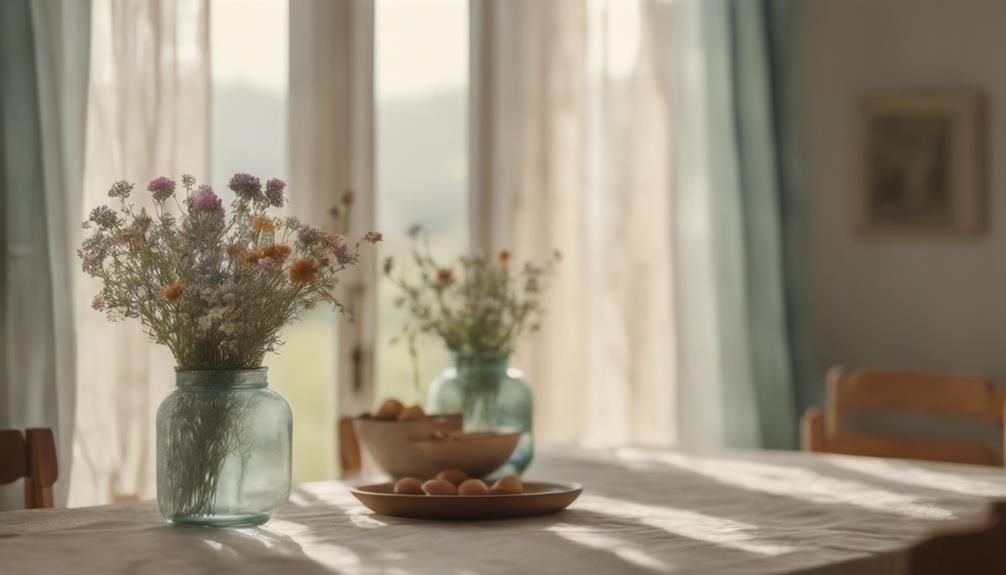
When it comes to decorative elements, you'll want to focus on pieces that enhance your space without adding clutter.
Consider a dried flower wall hanging or a woven basket filled with dried herbs to bring a touch of nature indoors.
A hand-painted ceramic vase can also serve as a beautiful focal point while keeping the overall aesthetic simple and serene.
Dried Flower Wall Hanging
Dried flower wall hangings effortlessly bring a touch of nature indoors, enhancing the minimalist Cottagecore aesthetic with their simple elegance. By incorporating these beautiful arrangements, you create a serene and inviting atmosphere that elevates your space. Selecting locally sourced or homegrown flowers not only fosters a deeper connection to nature but also adds a rustic charm to your decor.
To craft your own dried flower wall hanging, start by choosing flowers that resonate with your style. Dry them properly to preserve their beauty, then arrange them thoughtfully to maintain an uncluttered look. Soft, neutral tones of dried flowers work perfectly with a minimalist color palette, ensuring your wall hanging complements your overall design.
Don't shy away from mixing textures; incorporating grasses and delicate blooms adds depth while keeping the aesthetic cozy and inviting. This artistic expression allows you to personalize your home while remaining true to the principles of minimalism.
Embrace the tranquility and warmth that dried flower wall hangings can bring, making your space feel like a peaceful retreat infused with the beauty of nature.
Woven Basket With Dried Herbs
Incorporating a woven basket filled with dried herbs not only enhances your decor but also brings the calming scents of nature into your home. Woven baskets serve as both functional storage and decorative elements, perfect for maintaining a clutter-free, minimalist cottagecore aesthetic. By selecting baskets made from natural materials like seagrass or rattan, you emphasize your connection to nature, a key principle in both styles.
Arranging dried herbs such as lavender, rosemary, or thyme in your woven basket adds a rustic charm while infusing your space with delightful aromas. This curated display can bring warmth and color to a neutral palette, enhancing the tranquil atmosphere associated with cottagecore living.
Not only do these baskets serve as beautiful accents, but they also promote simplicity and celebrate the beauty of nature. By showcasing your personal style through these thoughtfully arranged elements, you create a serene home environment that invites relaxation and peace.
Hand-Painted Ceramic Vase
Hand-painted ceramic vases add a unique charm to your home, showcasing artisanal craftsmanship that perfectly complements the minimalist Cottagecore aesthetic. These vases often feature soft pastel colors and floral motifs, bringing a gentle touch to your decor while aligning with the serene palettes that define both styles.
Incorporating hand-painted ceramic vases into your space not only enhances the visual appeal but also serves a practical purpose. They provide a beautiful display for fresh or dried flowers, breathing life into any room. The organic shapes and textures of these vases create a cozy feel, inviting warmth and comfort into your minimalist Cottagecore environment.
Opting for vintage-inspired hand-painted ceramic vases supports sustainable decor by promoting artisan craftsmanship. This choice reduces reliance on mass-produced items, allowing you to fill your home with character and soul. Each vase tells a story and adds a personal touch to your decor, making it a perfect addition for those seeking a peaceful home.
Embrace the combination of artistry and simplicity with hand-painted ceramic vases and transform your living space into a serene haven.
Flooring

When you choose flooring for your cottagecore minimalist home, consider options like reclaimed barn wood planks, cork, or natural stone tile.
These materials not only bring warmth and character but also align with the peaceful, natural aesthetic you're aiming for.
Each choice can enhance your space while keeping maintenance simple and stress-free.
Reclaimed Barn Wood Planks
Reclaimed barn wood planks offer a sustainable flooring choice that beautifully complements the rustic charm of minimalist Cottagecore interiors. Sourced from old barns and industrial buildings, these planks reduce the need for new lumber, minimizing your environmental impact. Their unique character, marked by weathered textures, knots, and varying colors, adds authenticity and warmth to your home.
When you install reclaimed barn wood planks, you're not just enhancing aesthetics; you're creating a cozy atmosphere that resonates with both Cottagecore and minimalist philosophies. This type of flooring is often more durable than new wood, having been seasoned over many years, making it ideal for high-traffic areas while providing a timeless look.
Moreover, reclaimed wood flooring can improve indoor air quality, as it typically lacks the harmful chemicals found in new flooring materials. By choosing reclaimed barn wood, you're investing in a flooring option that combines beauty, durability, and sustainability, aligning perfectly with your desire for a peaceful and inviting home.
Embrace the charm of reclaimed wood and transform your space into a serene retreat that reflects your values and style.
Cork Flooring for Warmth
Cork flooring brings a natural warmth and comfort to your home, perfectly aligning with the serene essence of minimalist Cottagecore design. This sustainable and eco-friendly option is made from the bark of cork oak trees, which regenerates naturally and requires minimal processing.
With excellent thermal insulation, cork flooring helps maintain a cozy environment, especially during colder months, allowing you to enjoy warmth and charm in your living spaces.
The natural cushioning of cork flooring not only reduces noise but also provides comfort underfoot, making it ideal for creating serene spaces where you can unwind. Its hypoallergenic properties and resistance to mold and mildew contribute to a healthier indoor environment, which resonates with the Cottagecore emphasis on nature and wellness.
Available in various textures and colors, cork flooring complements the neutral and earthy tones of the minimalist Cottagecore aesthetic effortlessly. By choosing this type of flooring, you embrace a natural design that enhances the tranquil atmosphere of your home while also being kind to the planet.
Invest in cork flooring for a beautiful blend of functionality and style, and enjoy the cozy haven you've always wanted.
Natural Stone Tile Flooring
Natural stone tile flooring offers a sustainable and stylish choice that seamlessly blends rustic charm with minimalist elegance in your home. Made from natural materials like slate, marble, or limestone, this flooring option isn't only durable but also environmentally friendly. It provides a timeless aesthetic that enhances the serene atmosphere essential for both Cottagecore and Minimalist design.
With its excellent thermal mass, natural stone helps regulate indoor temperatures, contributing to energy efficiency in your modern home. The varied textures and colors of the tiles create a visually appealing yet uncluttered foundation, allowing you to incorporate cozy home decor elements without overwhelming the space.
Moreover, natural stone tile flooring is easy to maintain and clean, aligning perfectly with the minimalist ethos of functionality and practicality. It supports a peaceful and inviting home environment, making it an ideal choice for anyone looking to combine the warmth of Cottagecore with the simplicity of Minimalism.
Conclusion
By blending cottagecore's warmth with minimalism's simplicity, you create a peaceful haven that reflects your style. Incorporating natural elements like wood and botanical motifs can enhance the cozy, relaxed atmosphere of your space. You can also consider incorporating Scandinavian decor ideas, such as clean lines and neutral tones, to further emphasize the serene and uncluttered feel of your home. By combining these elements, you can create a harmonious and inviting environment that truly embodies your unique aesthetic.
Embrace natural materials and choose essential furniture pieces that bring comfort without clutter.
Soft lighting and thoughtful decorative accents enhance the cozy atmosphere, while clean flooring ties everything together.
This harmonious fusion invites serenity into your home, allowing you to unwind and reconnect with nature.
So go ahead, curate your space and enjoy the tranquility you've created.
